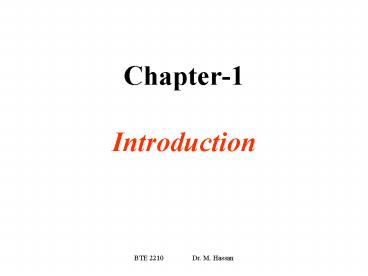Chapter1 Introduction PowerPoint PPT Presentation
1 / 16
Title: Chapter1 Introduction
1
Chapter-1 Introduction
2
Historical development
- Early humans (Stone, wood, clay, skins, ..)
- New material discovered (e.g., pottery, ..)
- Properties can be altered by heat treatment and
alloying. - Transformation from material selection to
material synthesis (relating microstructure to
properties)
3
Definitions
- Material science
- Investigating the relationships that exist
between the structures and properties of
materials. - Materials engineering
- Designing or engineering the structure of a
material to produce predetermined set of
properties (based on structure property
relationship).
4
Processing - Structure Properties
-Performance
- Materials are... engineered structures...not
black boxes! - Structure
- Subatomic (electrons), Atomic (atoms and
molecules), Microscopic (dislocations),
Macroscopic (Naked eye).
5
Structure
- Structure...has many dimensions...
Structural feature
Dimension (m)
-10
lt 10
atomic bonding
-10
missing/extra atoms
-10
10
-8
-1
crystals (ordered atoms)
10
second phase particles
-8
-4
10
-10
crystal texturing
-6
gt 10
6
Structure, Processing, Properties
- Properties depend on structure (e.g.,
hardness vs. structure of steel) - Processing can change structure (e.g.,
structure vs. cooling rate of steel)
Hardness (BHN)
7
Electrical
- Electrical Resistivity of Copper
- Adding impurity atoms to Cu increases
resistivity. - Deforming Cu increases resistivity.
8
Optical
- Transmittance
- Aluminum oxide
- may be
- transparent, translucent, or
- opaque depending on the material structure.
9
Deteriorative
10
(No Transcript)
11
Material classification
- Based on what ?
- Chemical makup and atomic structure
- (1) Metals
- (2) Ceramics
- (3) Polymers
- Composites
- Semiconductors
- BIOMATERIALS
12
Metals
- Combinations of metallic elements.
- Large number of nonlocalized electrons (sea of
electrons) This determines metal properties. - Good conductors to heat and electricity.
- Opaque to visible light.
- Strong BUT deformable (THUS, heavily used in
structures).
13
Ceramics
- Compounds between metallic and nonmetallic
elements (oxides, nitrides, carbides, ..) (e.g.,
clay minerals, cement, glass, ..) - Insulative to heat and electricity.
- Hard BUT brittle
- Resist harsh environment than metals.
14
Polymers
- Many are organic compounds based on carbon,
hydrogen and other nonmetals (e.g. rubber,
plastic, ..). - Large molecular structure.
- Low density and extremely flexible.
15
CompositesSemiconductors
- More than one material e.g., fiberglass
(glass in polymers), glass gives strength,
polymer gives flexibility. - Electrical properties between conductors and
insulators, properties depend on amount of
impurities present.
16
Biomaterials
- Employed in compounds implanted into the human
body. - Must be compatible with body tissues.
- All previous materials can be employed.

